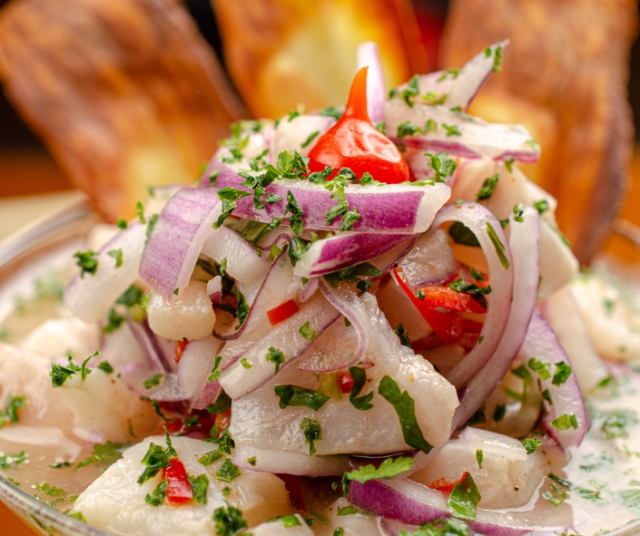Ceviche, a jewel of Peruvian gastronomy, is much more than a dish; It is a manifestation of cultural identity and a celebration of the fresh flavors of the sea. Every year on June 28, Peru and other countries with a rich culinary tradition come together to celebrate "Cebiche Day." This holiday not only highlights the excellence of this dish, but also serves as a tribute to the diversity of ingredients and culinary techniques that make it up.
Origins and History of Cebiche
Ceviche, also known as ceviche, has its roots in the ancient coastal cultures of South America, including pre-Columbian civilizations such as the Incas and the Mochicas. It is believed that ceviche was prepared by these civilizations using marinating techniques in acidic fruit juice, such as lemon, to cook fresh seafood. This culinary practice was adopted by the Spanish during the conquest of the region and later spread throughout Latin America.
Ingredients and Preparation
Peruvian ceviche is a dish that embodies the freshness of the sea and the richness of local flavors. Its preparation, although seemingly simple, is a meticulous process that requires attention to detail and respect for the ingredients.
The heart of ceviche lies in the quality of the fish used. Traditionally, the use of white fish with firm flesh and soft texture, such as sole, sea bass or grouper, is preferred. It is crucial that the fish is fresh, as this ensures optimal flavor and juicy texture. In Peruvian markets, local fishermen offer a wide variety of fresh options that make the perfect base for ceviche.
Once the fish has been selected, it is cut into uniform cubes of moderate size. This technique ensures that the fish is marinated evenly and cooked evenly in the lemon juice. In addition to the fish, the ceviche marinade is mainly made up of freshly squeezed lemon juice. The acid in lemon is essential not only to enhance the flavor of the fish, but also to slightly "cook" the meat, making it more tender and safe to eat.
Salt and chili (hot pepper) are essential ingredients that add depth and complexity to the flavor of ceviche. The salt highlights the natural flavors of the fish and balances the acidity of the lemon, while the chili provides a touch of spiciness that awakens the senses and adds a characteristic heat to the dish. The amount of chili used varies according to personal preference and tolerance to spiciness, but we always seek to maintain a balance between flavor and spiciness.
In addition to these basic ingredients, ceviche can incorporate a variety of accessories that add texture and flavor. The red onion, thinly sliced or diced, provides a crunchy touch and a slightly sweet flavor that contrasts with the acidity of the lemon. Fresh cilantro, with its herbaceous aroma, adds a touch of freshness that elevates the flavor profile of the dish.
To accompany ceviche, traditional garnishes such as slices of sweet potato and cooked corn are usually served. The sweet potato, with its sweet flavor and creamy texture, provides a delicious contrast to the acidity of the ceviche, while the corn provides a touch of sweetness and a slight crunch that complements the softness of the fish.
The Cultural Importance of Cebiche
Ceviche is not just a dish on the table; It is a symbol of identity and national pride for Peruvians. It is considered one of the most representative dishes of Peruvian gastronomy and has been internationally recognized as a prominent element of world cuisine. In 2004, the Congress of the Republic of Peru declared ceviche as part of the nation's cultural heritage, highlighting its historical and cultural importance.
Cebiche Day Celebrations
Cebiche Day is an annual celebration that brings together people of all ages and social classes around the table to enjoy this delicious dish. During this day, restaurants and street food stalls offer a variety of ceviches, from the most traditional to creative and contemporary versions.
In addition to enjoying the food, Cebiche Day is also an opportunity to pay tribute to the fishermen and fisherwomen who work hard to supply the markets with fresh fish. Many coastal communities host events and festivals that include ceviche competitions, cultural presentations, and demonstrations of traditional fishing techniques.
Cebiche in International Gastronomy
Over the past few decades, ceviche has gained popularity around the world and has become a featured dish on many international menus. World-renowned chefs such as Gastón Acurio have contributed to the dissemination of Peruvian cuisine, including ceviche, through the opening of restaurants and participation in international culinary events.
In places like the United States, Spain and Japan, ceviche has been adapted to local tastes, incorporating regional ingredients and culinary techniques. However, the essence of the dish, its freshness and vibrant flavor, remains intact, which has contributed to its growing popularity around the world.
As interest in Peruvian cuisine continues to grow, the future of ceviche looks bright. Chefs are experimenting with new ingredients and presentations, while consumers seek authentic and exciting culinary experiences. Additionally, sustainability is becoming increasingly important in the seafood industry, which could lead to a more responsible approach to sourcing key ceviche ingredients.
